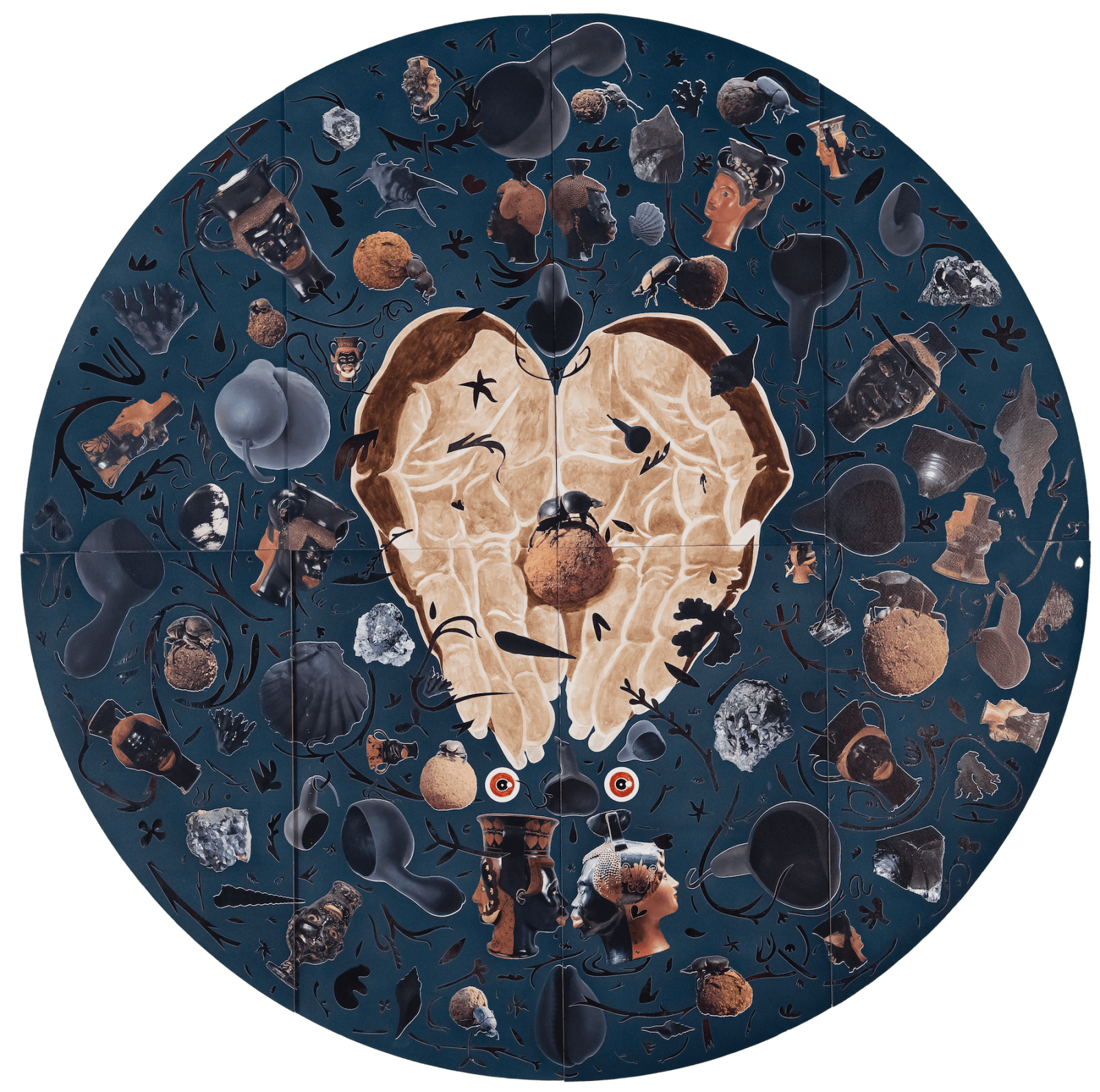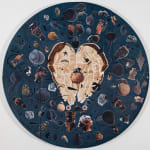WILLIAM VILLALONGO
Black Menagerie (Khepri & Janus), 2023
Acrylic, velvet flocking and paper collage on wood panel
47 3/4 in. dia. x 2 3/4 in.
Copyright The Artist
Further images
In this work, the cupped hands of Brown University Classics Professor Sasha Mae Eccleston present the viewer with a scarab. The insect, also known as a dung beetle, characteristically rolls...
In this work, the cupped hands of Brown University Classics Professor Sasha Mae Eccleston present the viewer with a scarab. The insect, also known as a dung beetle, characteristically rolls its egg intoa ball of excrement, burying the ball to ensure a safe place for incubation. Three months later, the offspring emerge, ready to repeat the life cycle.
Ancient Egyptians believed the scarab to be a reincarnation of Khepri, the God of resurrection and creation. During a period of Mediterranean migration (1st millenium BCE) , the scarab myth spread beyond egypt and entered Greco-Roman religious practices as a symbol of renewal, growth, and transformation.
Janus, the Roman God of beginnings, is generally depicted as having two faces, providing a view to both past and future at once. The Janiform vases found in Northern Italy notably depict the faces as one white and one Black. The appearance of both Scarabs and Janiform vases here suggests the cross-cultural exchange that occurred between Ancient Egypt and the larger Roman Empire.
During his residency in Rome, Villalongo visited numerous archeological collections where he discovered a surprising number of Janiform vases. While preserved, the vessels lacked documentation and research, making a case for the need for greater study in the area of Black history in Western antiquity.
Ancient Egyptians believed the scarab to be a reincarnation of Khepri, the God of resurrection and creation. During a period of Mediterranean migration (1st millenium BCE) , the scarab myth spread beyond egypt and entered Greco-Roman religious practices as a symbol of renewal, growth, and transformation.
Janus, the Roman God of beginnings, is generally depicted as having two faces, providing a view to both past and future at once. The Janiform vases found in Northern Italy notably depict the faces as one white and one Black. The appearance of both Scarabs and Janiform vases here suggests the cross-cultural exchange that occurred between Ancient Egypt and the larger Roman Empire.
During his residency in Rome, Villalongo visited numerous archeological collections where he discovered a surprising number of Janiform vases. While preserved, the vessels lacked documentation and research, making a case for the need for greater study in the area of Black history in Western antiquity.
Exhibitions
"William Villalongo: Myths and Migrations," Grinnell College Museum of Art, Grinnell, IA, 26 January 2024 - 6 April 2024; traveled to the Madison Museum of Contemporary Art, Madison, WI, 4 May 2024 - 18 August 2024; Museum of Art, University of Colorado, Boulder, CO, 13 September - 21 December 2024; Pennsylvania Academy of Fine Arts, Philadelphia, PA, 15 May 2025 - 31 August 2025."William Villalongo: Black Menagerie," Susan Inglett Gallery, NYC 7 September 2023 - 14 October, 2023.







